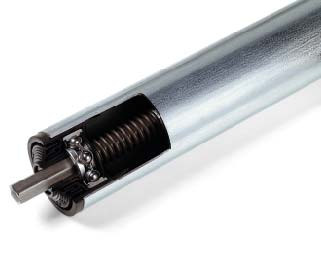 Conveyor system applications are really priceless to modern businesses. The idea of gravity roller conveyors has been around since the beginnings of documented history. It is believed the roller technique was used in the building of the ancient Egyptian pyramids and Stonehenge, amongst many other things.While roller conveyors have been in existence probably ever since the caveman, it wasn't till the 20th century this technology was taken into practicality. It was about this time that the idea that several individuals could successfully move a commodity from one place to another, without the need of actually moving themselves. http://www.conveyorrollers.co.uk/ always have an array of new chain driven rollers in stock.
Conveyor system applications are really priceless to modern businesses. The idea of gravity roller conveyors has been around since the beginnings of documented history. It is believed the roller technique was used in the building of the ancient Egyptian pyramids and Stonehenge, amongst many other things.While roller conveyors have been in existence probably ever since the caveman, it wasn't till the 20th century this technology was taken into practicality. It was about this time that the idea that several individuals could successfully move a commodity from one place to another, without the need of actually moving themselves. http://www.conveyorrollers.co.uk/ always have an array of new chain driven rollers in stock.
Earlier utilization of conveyor solutions
There isn't any doubt that conveyor roller methods have already been a fundamental element of material managing for over One hundred years, though their origin ranges back beyond this time. Movement of bulk products employing conveyor belts extends back to around 1795 when the majority of the system was utilized by farmers to load whole grains onto boats. It was a great relief to farmers after working hard in the fields.They were also employed in underground mines when the industry started using them to move coal.
A couple of points in history
- It wasn't up until the early 19th Century that factories started making use of conveyor systems in material handling.
- The greatest milestone started in 1908 when Hymle Goddard, from Logan Company patented the first roller conveyor in 1908. Despite this conveyor business didn't completely thrive until 5 years afterwards.
- In 1913 Henry Ford made history by adding the assembly line to the mainstream industry by utilizing the roller conveyor to alter material movement. This emerging trend decreased manual labour requirements and accelerated production.
- In the 1920s, conveyor roller systems were invented to transport products over longer distances from the original short distances. The first underground advanced assembly with layers of rubber and cotton covers was built to move coal over a distance of 8kms.
- Over the time period of the World War II, artificial belting materials were used due to the scarcity of natural materials. This marked the rapid technological expansion in improved conveyor systems. Up to today an infinite list of synthetic materials and polymers are used in production conveyor roller belting systems.
- Within the 1970's, 80s and 90s, conveyor equipment makers developed and improved powered conveyor rollers to get rid of high priced maintenance.
From then, breakthroughs in modern technology and innovation have kept conveyor roller systems on the leading edge; with the use of computers to deal with complicated and programmed applications, flexibility and optimal performance.Modifications in technology are guaranteed to hold the industry in motion as consumers look for faster throughput, diverted sorting and use of wireless technology.
The utilization of conveyor roller systems in modern society
 Although the belt conveyor has its drawbacks, numerous industries nowadays are filled with roller conveyors because it allows for automatic accumulation of products. In today's computer planet, roller conveyors still play a crucial part. Roller conveyor solutions are employed in the vehicle, computer, agricultural, food processing, pharmaceutical, aerospace, inorganic, canning and bottling industrial sectors, to name a few.While most folks might be unacquainted with it, modern systems have millions of rollers working relentlessly behind the curtain. From food, postal mail, courier, airport luggage, clothing and industrial packages, conveyor rollers are being used in movement to designated destinations.There are several other kinds of item movement systems, however it is only roller conveyor systems that can function as centres for accumulation and routes for movement simultaneously. There are very few innovations with similar influence on society such as the conveyor roller equipment.
Although the belt conveyor has its drawbacks, numerous industries nowadays are filled with roller conveyors because it allows for automatic accumulation of products. In today's computer planet, roller conveyors still play a crucial part. Roller conveyor solutions are employed in the vehicle, computer, agricultural, food processing, pharmaceutical, aerospace, inorganic, canning and bottling industrial sectors, to name a few.While most folks might be unacquainted with it, modern systems have millions of rollers working relentlessly behind the curtain. From food, postal mail, courier, airport luggage, clothing and industrial packages, conveyor rollers are being used in movement to designated destinations.There are several other kinds of item movement systems, however it is only roller conveyor systems that can function as centres for accumulation and routes for movement simultaneously. There are very few innovations with similar influence on society such as the conveyor roller equipment.